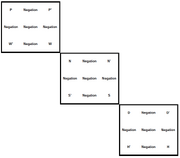mNo edit summary |
(Adding categories) |
||
| Line 39: | Line 39: | ||
From the above, it is easy to see that the Dimensions under consideration mount quickly, and as I have pointed out elsewhere, it is these Dimensions, interacting in concert, that make any such system difficult to understand, much less to resolve. |
From the above, it is easy to see that the Dimensions under consideration mount quickly, and as I have pointed out elsewhere, it is these Dimensions, interacting in concert, that make any such system difficult to understand, much less to resolve. |
||
| + | [[Category:School of Hard Knocks]] |
||
| + | [[Category:Logic]] |
||
Latest revision as of 22:29, 23 April 2018
Explicit and Implicit Arguments:

Taylor's Implicit Argument
EVIDENCE:
P = PEACE [IS / MUST HAVE BEEN] OBSERVED
P’ = PEACE [IS NOT / CANNOT HAVE BEEN] OBSERVED
W’ = WAR [IS NOT / CANNOT HAVE BEEN] OBSERVED
W = WAR [IS / MUST BE] OBSERVED
REASON:
N = NECESSARILY IMPLIES
N’ = [DOES NOT / CANNOT] NECESSARILY IMPLY
S’ = [DOES NOT / CANNOT] SUFFICIENTLY IMPLY
S = SUFFICIENTLY IMPLIES
[AGENCY / CAUSATION]:
D = “DOVE” ORDER [IS / MUST HAVE BEEN ] GIVEN
D’ = “DOVE” ORDER [IS NOT / CANNOT HAVE BEEN] GIVEN
H’ = “HAWK” ORDER [IS NOT / CANNOT HAVE BEEN] GIVEN
H = “HAWK” ORDER [IS / MUST HAVE BEEN] GIVEN
By Negating Evidence, Reason, and Agency combined, the situation is entirely objective; a tree falling in a forest with no one present to hear it. The events unfold as if they were caused by the Laws of Physics, without any need for Human involvement or intervention. They are Fated to occur, however they might. The distinctions between Agency and Causation, Cause and Effect, Past and Future, and between the Logical and Physical Modalities, form additional dimensions, making it possible to imagine this set of arguments as being essentially Seven Dimensional. This makes the real nature of the argument exceptionally difficult to grasp in its entirety for those with a limited capacity for multi-dimensional cognitive processing.
It is because Taylor presents his argument in the Logical Modality that all the trouble really arises, as he is then able to introduce his initial theorems, theorems which themselves do not answer to Evidence or Reason, but are upheld strictly by Fiat; they are Axiomatic to the nature of the Logical Modality, but are intuitively and rightfully seen as both foreign and useless to the Physical Modality. In the Logical Modality, we can safely conclude from an extraordinarily limited set of statements that our conclusion is Sufficient, whereas in the Physical Modality, we must consider far more numerous influences, and can only be relatively assured of the Sufficiency of our conclusions, based on the collective strength of a host of Necessary influences.
Further, we have never agreed upon a Formal and Logical distinction between Causation and Agency, but most often take the position that there is a continuum between the two. In practical application, we make the distinction between Moral and Immoral, and Culpable and Inculpable, based on the forcefulness of Causation with which an Agent may have been presented; diminished capacity, duress, mens rea – all such terms are expressions of the power of Causation to alter or diminish a person’s Agency and will to choose.
From the above, it is easy to see that the Dimensions under consideration mount quickly, and as I have pointed out elsewhere, it is these Dimensions, interacting in concert, that make any such system difficult to understand, much less to resolve.